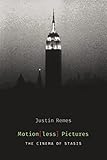Motion(less) Pictures : The Cinema of Stasis / Justin Remes.
Material type: TextSeries: Film and Culture SeriesPublisher: New York, NY : Columbia University Press, [2015]Copyright date: ©2015Description: 1 online resource (216 p.) : ‹B›10 b&w photographs‹/B›Content type:
TextSeries: Film and Culture SeriesPublisher: New York, NY : Columbia University Press, [2015]Copyright date: ©2015Description: 1 online resource (216 p.) : ‹B›10 b&w photographs‹/B›Content type: - 9780231169622
- 9780231538909
- 791.43
- PN1995.9.E96 R395 2015
- PN1995.9 .E96 R395 2015
- online - DeGruyter
- Issued also in print.
| Item type | Current library | Call number | URL | Status | Notes | Barcode | |
|---|---|---|---|---|---|---|---|
 eBook
eBook
|
Biblioteca "Angelicum" Pont. Univ. S.Tommaso d'Aquino Nuvola online | online - DeGruyter (Browse shelf(Opens below)) | Online access | Not for loan (Accesso limitato) | Accesso per gli utenti autorizzati / Access for authorized users | (dgr)9780231538909 |
Browsing Biblioteca "Angelicum" Pont. Univ. S.Tommaso d'Aquino shelves, Shelving location: Nuvola online Close shelf browser (Hides shelf browser)

|

|

|

|

|

|

|
||
| online - DeGruyter The Lumière Galaxy : Seven Key Words for the Cinema to Come / | online - DeGruyter Why We Dance : A Philosophy of Bodily Becoming / | online - DeGruyter The Highway of Despair : Critical Theory After Hegel / | online - DeGruyter Motion(less) Pictures : The Cinema of Stasis / | online - DeGruyter Global Alert : The Rationality of Modern Islamist Terrorism and the Challenge to the Liberal Democratic World / | online - DeGruyter Theatre and Evolution from Ibsen to Beckett / | online - DeGruyter Marching Through Suffering : Loss and Survival in North Korea / |
Frontmatter -- Contents -- Acknowledgments -- 1. Introduction -- 2. Serious Immobilities -- 3. Stasis in Fluxus -- 4. Boundless Ontologies -- 5. Colored Blindness -- 6. Conclusion -- Appendix 1. The Cinema of Stasis -- Appendix 2. Films Relevant to Understanding the Cinema of Stasis -- Notes -- Index -- Backmatter
restricted access online access with authorization star
http://purl.org/coar/access_right/c_16ec
Conducting the first comprehensive study of films that do not move, Justin Remes challenges the primacy of motion in cinema and tests the theoretical limits of film aesthetics and representation. Reading experimental films such as Andy Warhol's Empire (1964), the Fluxus work Disappearing Music for Face (1965), Michael Snow's So Is This (1982), and Derek Jarman's Blue (1993), he shows how motionless films defiantly showcase the static while collapsing the boundaries between cinema, photography, painting, and literature. Analyzing four categories of static film--furniture films, designed to be viewed partially or distractedly; protracted films, which use extremely slow motion to impress stasis; textual films, which foreground the static display of letters and written words; and monochrome films, which display a field of monochrome color as their image--Remes maps the interrelations between movement, stillness, and duration and their complication of cinema's conventional function and effects. Arguing all films unfold in time, he suggests duration is more fundamental to cinema than motion, initiating fresh inquiries into film's manipulation of temporality, from rigidly structured works to those with more ambiguous and open-ended frameworks. Remes's discussion integrates the writings of Roland Barthes, Gilles Deleuze, Tom Gunning, Rudolf Arnheim, Raymond Bellour, and Noel Carroll and will appeal to students of film theory, experimental cinema, intermedia studies, and aesthetics.
Issued also in print.
Mode of access: Internet via World Wide Web.
In English.
Description based on online resource; title from PDF title page (publisher's Web site, viewed 02. Mrz 2022)


